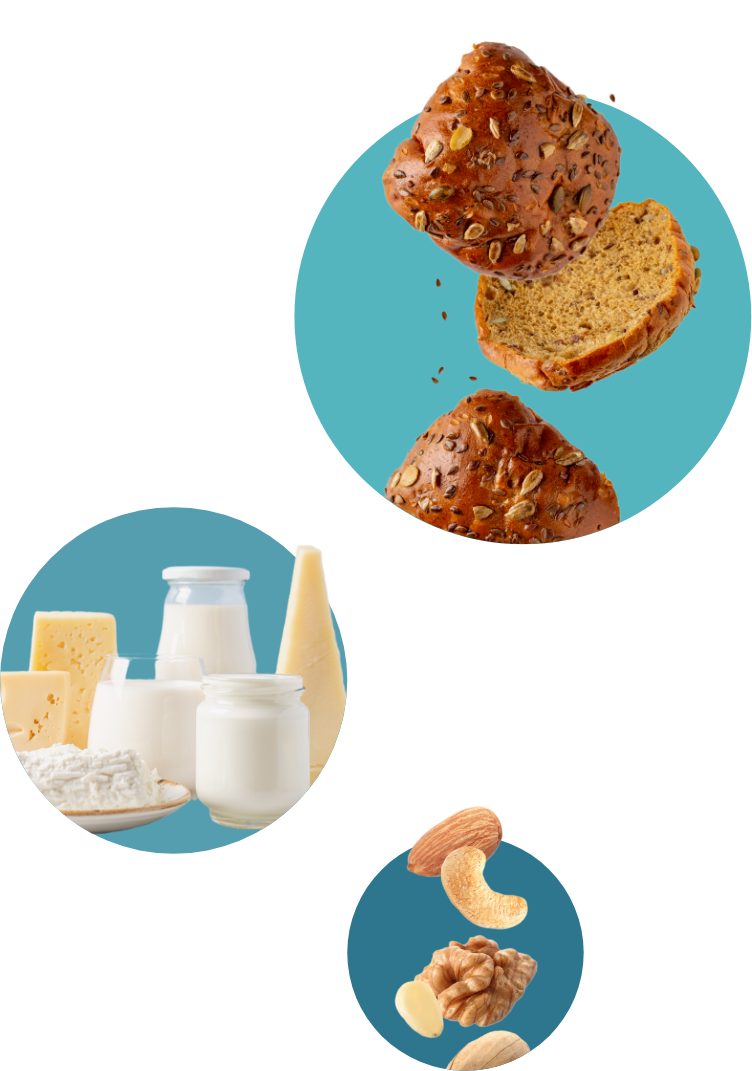

What Is a Food Allergy?
A food allergy, classified as an adverse reaction to food, involves an abnormal immune response triggered by specific proteins. This immune response is primarily mediated by immunoglobulin E (IgE). The activation of IgE leads to the release of various chemical mediators, including histamine, prostaglandins, tryptase, and leukotrienes. These released chemicals are responsible for the manifestation of food allergy symptoms.

Food Allergy vs Food Intolerance
Food allergies and food intolerances represent distinct reactions to food, differing in their underlying mechanisms and severity of symptoms. Food intolerances are adverse reactions primarily triggered by nonimmunologic factors, often confining their effects to the digestive system. These reactions, although uncomfortable, are generally not as severe as food allergies. Common symptoms of food intolerance include nausea, gas, cramps, abdominal pain, diarrhea, irritability, or headaches. Examples of food intolerances encompass various factors, such as the pharmacologic properties of the food (like simple sugars causing hyperactivity in children), toxins in the food (as seen in scombroid fish poisoning), foods that exacerbate gastroesophageal reflux (typically acidic or spicy foods), metabolic disorders (e.g., lactose intolerance), and autoimmune conditions provoked by gluten exposure (as observed in celiac disease). These distinctions help individuals and healthcare professionals differentiate between the various responses to food, making it essential to properly identify and manage each type of reaction.
What Are the Symptoms of Food Allergies?
Food allergies can cause either immediate or chronic symptoms. Below are some common symptoms.
Hives
Raised, itchy skin welts that can vary in size and shape
Swelling
Swelling of the face, lips, tongue, or throat
Atopic Dermatitis (eczema)
A chronic skin condition characterized by redness, itching, and rash
Gastrointestinal Symptoms
Includes abdominal pain, cramping, or diarrhea
Throat Tightness
A sensation of constriction or narrowing in the throat, which can be alarming
Vomiting
Sudden and forceful expulsion of stomach contents, often due to severe allergic reactions
Difficulty Breathing
Respiratory distress, characterized by shortness of breath or wheezing
Anaphylaxis
Severe, potentially life-threatening allergic reaction
Failure to Thrive
Pediatric patients may experience inadequate weight gain and growth

What Are the Most Common Food Allergens?
Although almost any food can lead to an allergic reaction, the most common food allergens include:
- Cow’s Milk: Dairy products such as cow’s milk, cheese, butter and yogurt
- Egg: Found in several foods as obvious as scrambled eggs and omelets, to french toast, pancakes, waffles and baked goods such as cake and cookies
- Wheat: Present in many grains and foods, including bread, pasta, and cereals
- Soy: Also known as edamame beans, it’s commonly found in processed foods, soy sauce, and tofu
- Peanut: A prevalent allergen found in peanut butter, snacks, and certain sauces
- Tree nuts: Includes almonds, walnuts, hazelnuts, pine nuts, macadamia nuts, pistachios, and cashews and often found in desserts and baked goods
- Fish: Such as salmon, tuna, halibut, whitefish and codfish, commonly served in various culinary preparations
- Shellfish: Includes crustaceans like shrimp, crab, and lobster, as well as mollusks like clams, mussels, and oysters
Diagnosing & Treating Food Allergies
Food Allergy Testing in New Jersey
How to Get Tested for Food Allergies?
Diagnostic testing will be used to identify which food(s) the patient is allergic to.
Treatment of Food Allergies in New Jersey
The primary treatment for food allergies is avoidance. Rescue medications do play a role in case of accidental exposure.
Food Allergy Related Conditions
Which Condition is Usually Associated With Food Allergies?

What is Eosinophilic Esophagitis (EoE)?
EoE is one of the more common types of eosinophilic gastrointestinal disorders. It is a chronic inflammatory condition of the esophagus that is characterized by the presence of increased eosinophils in the lining of the esophagus. Eosinophils are allergy cells that release inflammatory chemicals that can lead to irritation or damage to the esophagus and interfere with its function.
Symptoms of Eosinophilic Esophagitis:
- Failure to thrive in children
- Reflux
- Difficulty swallowing
- Food impaction in esophagus
Treatment for Eosinophilic Esophagitis:
- Avoidance of food triggers (both allergic and non-allergic) and environmental allergen triggers
- Allergen Immunotherapy (Allergy Shots)
- Medications: Proton Pump Inhibitors such as omeprazole (Prilosec) or esomeprazole (nexium), swallowed inhaled steroids such as fluticasone (Flovent) and budesonide (Pulmicort Respules)

What is Allergic Eosinophilic Gastroenteritis (AEG)?
This is a disease in which the lining of the GI tract becomes inflamed with eosinophils. Eosinophils are a type of white blood cell that play a prominent role in allergic inflammation. AEG can be the result of either a true food allergy or a poorly defined immune response to a food.
Common Foods Associated with Allergic Eosinophilic Gastroenteritis:
- Cow’s milk
- Egg
- Soy
- Peanuts
- Tree nuts
- Fish
- Shellfish
- Wheat
Treatment for AEG includes avoidance of the food trigger.

What is Food Protein Induced Enterocolitis Syndrome (FPIES)?
This is a non-IGE mediated food response that results in severe vomiting, diarrhea, and dehydration. Although any food can be associated with this diagnosis, the most common foods include cow’s milk, soy, rice and oats. It’s more common in young children and typically outgrown by ages 2-3 years old. However, FPIES can still be reported in older children and adults.
Symptoms are delayed, typically appearing 4-6 hours after ingestion of the food. Symptoms often resolve within 24 hours and include:
- Paleness & sweating
- Fatigue
- Vomiting
- Diarrhea
- Dehydration
Diagnosing & Treating FPIES
There is no diagnostic test for FPIES. Diagnosis is made based on clinical history. Treatment for FPIES includes strict avoidance of the allergen. If there is accidental exposure and symptoms develop, emergency treatment is necessary because of the risk of severe dehydration and cardiovascular collapse. Acute treatment includes the administration of intravenous fluids and possibly an anti-nausea medication such as ondansetron (Zofran).

What is Food Dependent Exercise Induced Anaphylaxis (FDEIA)?
FDEIA is a rare condition with a prevalence of 0.05%. It only occurs with the combination of a specific food and exercise. The patient can typically eat the food without symptoms. FDEIA only occurs if you eat and then exercise within 4-6 hours of ingestion. The reaction usually occurs within the first 30 minutes of starting physical activity. Symptoms include itchiness, hives and swelling, coughing, wheezing, chest tightness, abdominal pain, nausea, vomiting, and diarrhea.
Foods that have most often been reported to cause this condition include wheat, shellfish, nuts, tomatoes, peanuts, fish, pork, beef, mushrooms, hazelnuts, eggs, peaches, apples, milk, and alcohol.
Prevention involves avoiding the combination of the trigger food and exercise. Treatment includes having a food allergy action plan in place – which includes diphenhydramine (Benadryl) and an epinephrine auto-injector (EpiPen or Auvi-Q).

What is Oral Allergy Syndrome (Food Pollen Syndrome)?
This is a specific type of food allergy that is characterized by symptoms that are generally limited to the oral cavity and include:
- Itchy mouth
- Itchy throat
- Itchy tongue
- Swelling of the mouth, lips, or tongue
Oral allergy syndrome can progress to a severe allergic reaction, but this is very uncommon. This type of reaction occurs in the heat and acid-labile proteins are found in certain fresh fruits and vegetables. These delicate proteins are denatured (broken down) by heat and acid, and therefore if cooked or processed, patients will not react. This also explains why the reaction does not progress beyond oral symptoms because as soon as the food reaches the acid in the stomach, it again is denatured (or broken down). The proteins that lead to oral allergy syndrome are known to cross-react with certain pollen.
Examples of pollens and a few of their cross-reacting foods are listed below:
- Birch pollen: apple, peach, plum, pear, cherry, carrot
- Ragweed pollen: melon and banana
- Mugwort pollen (weed): carrot, broccoli, and celery
- Orchard pollen (grass): melon, tomato, white potato
Food Allergies FAQs
Will my child outgrow his/her food allergies?
It is not a simple answer. The majority of children with an allergy to cow’s milk, egg, soy and wheat will outgrow food allergies. On the other hand, only about 20% of patients with an allergy to peanut and tree nut will outgrow their food allergies.
For infants, is it better to introduce highly allergic foods earlier or to wait?
Earlier, as young as 4 months of life. Recent data suggests that the earlier introduction of foods results in a lower likelihood of developing food allergies.
If I am allergic to birch tree pollen should I automatically avoid fresh fruits such as apples, peaches, pears and plums?
No. Not all patients with pollen allergies develop oral allergy syndrome. Only avoid those foods in which symptoms appear.
Are there any FDA approved treatments for food allergies?
Yes. The only FDA approved treatment for food allergies at this time is Palforzia. This is peanut allergen powder that is used to desensitize individuals with a peanut allergy. It is an oral immunotherapy (OIT) treatment.
Are there any new treatments being studied for food allergies?
Yes. There are currently a number of different concepts being looked at to desensitize or make individuals “less allergic” to foods. Examples include:
Epicutaneous Immunotherapy (EPIT) to peanuts – commonly known as the “peanut patch”
Oral Mucosal Immunotherapy (OMIT) to peanuts – commonly known as the peanut toothpaste

